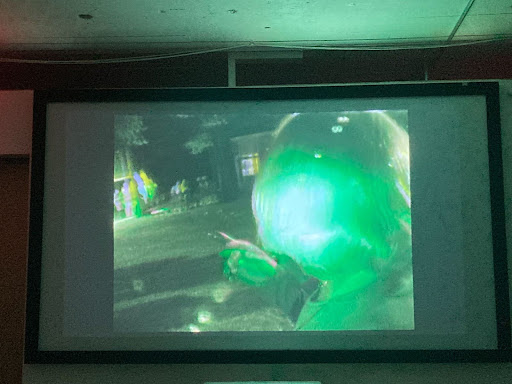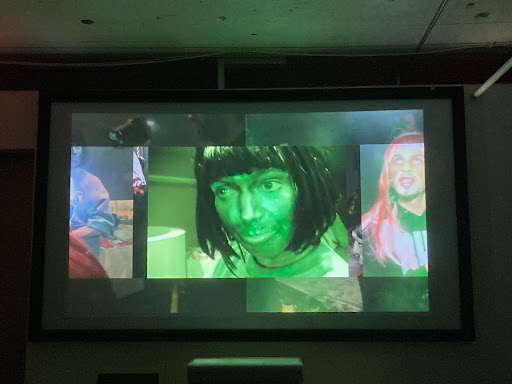Spacy, nestled along the Dallas Area Rapid Transit (DART) red train line, stands as a haven for film enthusiasts in the heart of the city. Programmed by the visionary Tony Nguyen, Spacy serves as a “third space” where audiences can immerse themselves in a curated selection of international films that challenge and inspire.
As one of the few culture venues in Dallas accessible directly by rail, Spacy welcomes cinephiles and curious explorers alike to experience the magic of cinema in an intimate and immersive setting. In this piece, I recap five films at Spacy in the past year.
****
Transexual Menace
Directed by Rosa von Praunheim, 1996, 1h 32m
Transexual Menace begins and ends so abruptly with an establishing shot of the film’s subjects at a pro-trans rights demonstration that one could easily recut the film. Its starting point could be moved, and it would retain much of its integral qualities. Or, perhaps, as it is, it could play in a continuous loop, with no beginning or end.
Through intimate interviews and candid footage, the documentary delves into the complexities of gender identity, self-expression, and personal history. What is striking is the diversity of people within the transgender community, with individuals expressing a range of nomenclature for describing their bodies and identities.
One of the film’s most powerful messages is the reminder that gender identity does not determine all aspects of a person’s life. We see successful people, as well as those navigating the challenges of transition in various environments, from educational seminars to workplaces.
The testimonials in Rosa von Praunheim’s documentary offer a captivating look into the lives of trans women, showcasing their experiences as sex workers, performers, and members of a collective community. These narratives provide insight into how individuals forge connections despite societal expectations conflicting with their gender identities. Each individual’s story is given full cinematic treatment: von Praunheim adds depth and nuance to the broader narrative of transgender experience by allowing the film’s subjects to act out the stories that they are narrating to the filmmaker.
Transsexual Menace is a thought-provoking documentary that sheds light on the resilience and diversity of the transgender community while challenging viewers to reconsider their preconceptions about gender and identity. Through von Praunheim’s lens, we are invited to empathize with individuals whose journeys transcend societal expectations and redefine what it means to live authentically.
****
Junior War
Directed by Ryan Trecartin, 2013, 24m
Junior War, a film by Ryan Trecartin, offers a raw and immersive glimpse into the tumultuous world of adolescence, where boundaries blur and social norms unravel in the dead of night.
Set in what appears to be a backyard party, the film unfolds with frenetic energy, capturing the reckless abandon and defiance of its young protagonists. As adolescents hurl brash epithets and engage in drunken destruction, the camera navigates the chaotic scene with an unflinching gaze, blurring the lines between observer and participant.
Trecartin’s signature quick splicing of shots creates a disorienting visual texture, reminiscent of cinema verité, as the narrative unfolds with a sense of urgency and unpredictability. The impending presence of law enforcement adds a layer of tension, yet the adolescents’ defiance remains palpable, even as social order begins to crumble.
Through its unfiltered portrayal of teenage rebellion and the search for identity, Junior War offers a visceral exploration of the adolescent experience, capturing the fleeting moments of exhilaration and uncertainty that define this transformative period of life.
While the film may feel invasive at times, its candid portrayal of youth culture serves as a powerful reminder of the complexities and contradictions inherent in the journey from adolescence to adulthood. In Junior War, Trecartin masterfully navigates the blurred boundaries between reality and performance, inviting viewers to confront the chaos and confusion of adolescence with unflinching honesty.
****
Comma Boat
Directed by Ryan Trecartin, 2013, 33m
The short film Comma Boat invites viewers into the typical Trecartin soundstage, where dialogue and speech create a complex interplay that reflects the contemporary moment. While the actors are speaking in exposition, the film diverges from chaos and embraces a more directed narrative, featuring characters with a reality TV demeanor that vie for attention and supremacy.
Garish makeup responds dynamically to the camera’s spotlight, creating a distinct visual impact, especially in close-ups where faces are illuminated intensely. The film adopts a documentary-style approach, akin to a Making the Band format. The storyline references “The Second Bang,” alluding to a future, paradigm-shifting event. Characters, often credited as “Hosts,” engage in a constant struggle for attention, displaying derision, haughtiness, and camp.
Ryan Trecartin, the director and a character in the film, represents a film production entity called Witness 360. Comma Boat also hints at a re-engagement with Junior War, featuring an era where many characters embody internet gender, or psycho-sexual identity which emerges from networked media. The overall tone of Trecartin’s films, resembling the cadence of a lively party, aligns with the sensation of children constructing worlds with cardboard boxes and styrofoam. Despite the occasional denigration of the camera, characters persist in their forward movement, creating a constant atmosphere of recklessness that leaves the viewer questioning whether the actors fully comprehend the events unfolding.
In one scene, Trecartin’s character delivers a line, stating, “Peace wherever the war is, that’s all I have to say.” His characters exist behind so many layers of artifice, that they pantomime reality only when the camera is looking.
****
Item Falls
Directed by Ryan Trecartin, 2013, 26m
In Item Falls, the surreal narrative of the notion of reality television and competition among actors is present once again. The film deconstructs archetypes as figures slip into eccentricities, including attempting questionable British accents.
In this film, animation is the subject, or rather, the product that the cast is ruminating on. In this context, “animation” is euphemistic for the environment or reality. Nouns, such as furniture and animals are identified as elements that comprise a scene. This shift signifies a departure into a post-real reality, with the most animated figures embodying a sense of perfection.
The film’s recursive syntax unveils a predictable pattern, emphasizing the idea that facts exist because they are believed in. A peculiar theme emerges, suggesting that figures within the narrative may need to audition their animations, perhaps to compete against one another. The interior spaces portrayed become either competitive arenas or metaphorical representations of the panopticon; similarly, auditioning becomes the mechanism through which characters assert their value, as they perpetually vie for authenticity in a world where competition shapes their reality. The narrative hints at a continual struggle among the characters to prove their realness in an environment laden with symbolism and unconventional dynamics.
****
Days of Being Wild
Directed by Wong Kar Wai, 1990, 1h 35m
In Wong Kar Wai’s Days of Being Wild, the labyrinthine streets of Hong Kong serve as the backdrop for a complex web of relationships and yearning. Set in the tumultuous 1960s, the film follows a cast of characters as they navigate love, loss, and the search for identity in a city where shadows conceal as much as they reveal.
The film’s distinctive visual style, characterized by a muted color palette of black and green, lends an air of mystery to its atmospheric settings. From dimly lit apartments to bustling streets, Kar Wai masterfully captures the essence of urban life, where every corner holds secrets waiting to be uncovered.
Against this backdrop, the characters engage in a delicate dance of intimacy and distance, their interactions tinged with longing and uncertainty. As relationships shift and evolve, the film explores themes of split possession and the search for belonging, highlighting the complexities of human connection in a city marked by constant flux.
Days of Being Wild is not a film of grand gestures or dramatic plot twists; rather, it revels in the subtleties of everyday life and the quiet moments of introspection that shape the characters’ journeys. With its slice-of-life dialogue and nuanced performances, the film offers a poignant meditation on the fleeting nature of time and the elusive quest for meaning.
William Sarradet is the Assistant Editor of Glasstire.







